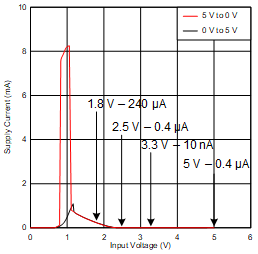SCEA047B November 2013 – November 2022 SN74LV1T00 , SN74LV1T02 , SN74LV1T04 , SN74LV1T08 , SN74LV1T32 , SN74LV1T86
2 Translating Down
Using these parts to translate down is very simple because the inputs are tolerant to 5.5 V, completely independent of supply voltage (VCC). The input high-state voltage can be any value from the defined minimum input high-state voltage (VIH) in the datasheet to 5.5 V, including above VCC.
The output high-level voltage (VOH) always equals the supply (VCC) level, which can be as low as 1.6 V. One advantage to down translating using this part is that the ICC current remains less than or equal to the maximum specified value in the datasheet as long as the input voltage is equal to or larger than the supply voltage. The typical switching thresholds for 3.3-V operation can be seen in Figure 2-1.
Common down translation possibilities with the LVxT family:
- 1.8-V VCC: from 2.5 V, 3.3 V, or 5 V down to 1.8 V
- 2.5-V VCC: from 3.3 V, to 5 V down to 2.5 V
- 3.3-V VCC: from 5 V down to 3.3 V
 Figure 2-2 Power
Consumption when Translating
Figure 2-2 Power
Consumption when Translating